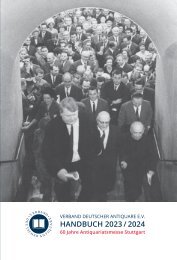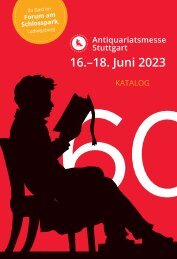- Seite 1 und 2:
SA N T•SI Q U A RTUTTI A TGAS MRE
- Seite 3 und 4:
alles sofort bestellbarWertvolle B
- Seite 5 und 6:
TeilnehmerverzeichnisName und Ort S
- Seite 7 und 8:
VorwortSehr geehrte Damen und Herre
- Seite 9 und 10:
Das virtuelle „Rote Sofa” der A
- Seite 11 und 12:
contains biographies and portraits
- Seite 13 und 14:
Berühmtes Kinderbuch - Comenius, J
- Seite 15 und 16:
Neapel (Napoli): „Napoli da Mare
- Seite 17 und 18:
- „Nova Totius Terravm Orbis Geog
- Seite 19 und 20:
und wellig. Nur vereinzelt gering b
- Seite 21 und 22:
band mit goldgeprägter Ornamentik
- Seite 23 und 24:
Hayn-Gotendorf IX, 603. - Götze C
- Seite 25 und 26:
übersetzt. Mit Kupfern. Vierte Auf
- Seite 27 und 28:
perron 1777 hielt, erkannte der Sch
- Seite 29 und 30:
primerie de W. Remquet et Cie1854-1
- Seite 31 und 32:
[Also numbered as: Nos. 1-13 (which
- Seite 33 und 34:
Partch, Dick Higgins, Philip Corner
- Seite 35 und 36:
Beuys - Federspiel, Jürg. Die best
- Seite 37 und 38:
Schinz, H(einrich) R(udolf). Abbild
- Seite 39 und 40:
ein handschriftlicher Vermerk: „N
- Seite 41 und 42:
Laurentius von Schnüffis (d. i. Jo
- Seite 43 und 44:
von ihm als sein einziger Freund be
- Seite 45 und 46:
Sabin 74384; Howes R 539. - Erste d
- Seite 47 und 48:
Duhamel du Monceau, Henri-Loius. Tr
- Seite 49 und 50:
Theologie, … Nebst dessen curieus
- Seite 51 und 52:
Todes mich beynahe befand, doch geh
- Seite 53 und 54:
Wolffheim I, 862; Gregory-Bartlett
- Seite 55 und 56:
VD18 10245960. - Hayn-Gotendorf II,
- Seite 57 und 58:
Lubasch/Meyer, S. 6. - WG² 8. - Er
- Seite 59 und 60:
Freyhold - Morgenstern, Ch(ristian)
- Seite 61 und 62:
im Jahre 1918. Der Dichter überlie
- Seite 63 und 64:
L. E. Margaret Gerhardt Hermann Kei
- Seite 65 und 66:
Hedwig HornburgDagmar HoogeEmma Nac
- Seite 67 und 68:
Very beautiful copy of the most sou
- Seite 69 und 70:
Martin Luther translated the Bible
- Seite 71 und 72: Hugo Bürkner (1818-1897). Bilderau
- Seite 73 und 74: Josef Schaffer (1757-1825). Bildtaf
- Seite 75 und 76: Friedrich Karl Waechter73
- Seite 77 und 78: Guillaume Apollinaire75
- Seite 79 und 80: Bibliotheken. Zu (1): Datiert: 1600
- Seite 81 und 82: Inkunabel. (Goff B334; GW 03858; HC
- Seite 83 und 84: Linnaean edition of the illustrated
- Seite 85 und 86: 24 engraved views made for the Empe
- Seite 87 und 88: Bilderbuches in Gegenüberstellung
- Seite 89 und 90: die mit Draht umwickelt und befesti
- Seite 91 und 92: etc.“ (Cox). Die Tafeln mit einem
- Seite 93 und 94: Harms / Schilling, Deutsche illustr
- Seite 95 und 96: Baum, Dora. „Tanz um den Maibaum
- Seite 97 und 98: „an die kubistischen Elemente im
- Seite 99 und 100: 97
- Seite 101 und 102: 99
- Seite 103 und 104: Mainz, Leipzig, Straßburg (Strasbo
- Seite 105 und 106: und Typographie sowie Symbole sind
- Seite 107 und 108: (first American edition - „a seco
- Seite 109 und 110: guards; each signed by Matisse in p
- Seite 111 und 112: in Hexenprozessen und die Rolle wel
- Seite 113 und 114: ædes ad Caianam uillam suis, & pro
- Seite 115 und 116: Vorsatz, Frontispiz und Titelblatt
- Seite 117 und 118: 1300 Abbildungen, meist mit mehrere
- Seite 119 und 120: (Naveau, Jean-Baptiste). Le Financi
- Seite 121: HWB 1956, 3803. Seyffert XXI. - Let
- Seite 125 und 126: The Torres Strait, and a vast Franc
- Seite 127 und 128: English Bible Manuscript[Biblia lat
- Seite 129 und 130: The birth of modern anatomy:a colou
- Seite 131 und 132: engraved plates. Contemporary unifo
- Seite 133 und 134: mit Beschreibungen“. Apart from t
- Seite 135 und 136: zahlreiche photographische Aufnahme
- Seite 137 und 138: Die Expedition von Rhodes in Orig.-
- Seite 139 und 140: Kollwitz, Ottilie. Fra mosen til vu
- Seite 141 und 142: Barrage Balloon - Marx, Enid. Bulgy
- Seite 143 und 144: Exemplar Nr. 51 der Vorzugsausgabe
- Seite 145 und 146: et une préface par la Princesse Bi
- Seite 147 und 148: erschienen. Brunels Unternehmen gel
- Seite 149 und 150: des ersten Bandes enthält vor alle
- Seite 151 und 152: Ungedruckt, kurz nach Wagners Rück
- Seite 153 und 154: „Und die große Stadt fraß Fraue
- Seite 155 und 156: 1935) adressieren; später bittet i
- Seite 157 und 158: wendung […] fanden! Und da ich nu
- Seite 159 und 160: Umfangreiche und gut lesbare chemis
- Seite 161 und 162: Jones, Owen. Grammatik der Ornament
- Seite 163 und 164: Eisen GeishaHirosada ChukoHiroshi Y
- Seite 165 und 166: Kuniyoshi Seishu gishiKunisada Sho-
- Seite 167 und 168: signiert. Die Holzstöcke wurden na
- Seite 169 und 170: Ernst, Max - Kuhlemann, Johannes Th
- Seite 171 und 172: Ballei angefertigt werden. Das Buch
- Seite 173 und 174:
„der Ernst der Tage“ - Weimar u
- Seite 175 und 176:
173
- Seite 177 und 178:
Perpetual Calendar. A Brass, Silver
- Seite 179 und 180:
Manuscript, German Military Archite
- Seite 181 und 182:
[Gelen, Sigismund, editor] - Notiti
- Seite 183 und 184:
betrieb er einen Lebensmittelgroßh
- Seite 185 und 186:
Ohne das letzte weiße Blatt; etwas
- Seite 187 und 188:
VD17 3:315265B - Bohatta 33 c - Med
- Seite 189 und 190:
Griechenland. Griechische Reise. Re
- Seite 191 und 192:
Drucke des 16. JahrhundertsHeiliges
- Seite 193 und 194:
auf die Einhaltung der Münzordnung
- Seite 195 und 196:
Monumentale Beschreibung des Kräut
- Seite 197 und 198:
gessenheit schützen.“ Die umfang
- Seite 199 und 200:
Stiches soll durch seine Tochter El
- Seite 201 und 202:
und San Sebastiano und tötete 20 u
- Seite 203 und 204:
Aus der Bibliothek vonJohann Ernst
- Seite 205 und 206:
Georg Wilhelm Pabst. Die erste deut
- Seite 207 und 208:
Palmireno, L. Vocabulario del human
- Seite 209 und 210:
(Vorster, K. A. v.). Der Rheingauer
- Seite 211 und 212:
Ginzburg, Mosei (Moissei Ginzbourg;
- Seite 213 und 214:
Erste Ausgabe, erster Druck. Versch
- Seite 215 und 216:
Luther, Martin. Der Psalter Deudsch
- Seite 217 und 218:
Calvin, Jean. Ioannis Calvini Opera
- Seite 219 und 220:
Heidelberg - Kirchner, Albert Emil.
- Seite 221 und 222:
Haas & Söhne in Wien, die ihm Must
- Seite 223 und 224:
Wilde, Oscar. The Picture of Dorian
- Seite 225 und 226:
Erstausgabe und eines von 80 Exempl
- Seite 227 und 228:
Malerei-Alben aus ChinaYoccqua, tä
- Seite 229 und 230:
sowie einer Vielzahl von Inseln, te
- Seite 231 und 232:
vom ‚Armenhaus‘ …“, mit eig
- Seite 233 und 234:
der Welt eine grosse Überraschung
- Seite 235 und 236:
Bloch, Marcus Élieser. Kupfer zu D
- Seite 237 und 238:
ments für die europäische Rechtsg
- Seite 239 und 240:
Bockstorffer, Christoffel (ca. 1480
- Seite 241 und 242:
Ploos van Amstel, Cornelis (1726-16
- Seite 243 und 244:
The most Famous English HerbalGerar
- Seite 245 und 246:
Cupids, Angels and Masks Engraved b
- Seite 247 und 248:
due to the lack of knowledge of the
- Seite 249 und 250:
separately. The current sales value
- Seite 251 und 252:
Derain, A. - Anacreon. Odes anacré
- Seite 253 und 254:
Picasso, P. - Suarés, AndréRaban,
- Seite 255 und 256:
Ansichten aus dem SchwarzwaldCoigne
- Seite 257 und 258:
Druckvorgängen originalgetreu wied
- Seite 259 und 260:
Bei diesem Zeichen von des Tunnels
- Seite 261 und 262:
un journal financier avec un bout-d
- Seite 263 und 264:
das Leben des Juristen Jacob Döple
- Seite 265 und 266:
Eines von 150 nummerierten Exemplar
- Seite 267 und 268:
Nummer 270 (!) von 270 Exemplaren.
- Seite 269 und 270:
finitionen […] sind dort zum erst
- Seite 271 und 272:
Der Besitzer der vorliegenden Hands
- Seite 273 und 274:
verkröpfte Ecken, Dachspitzen, ion
- Seite 275 und 276:
jene Sammlung erlangt“ (G. Karpel
- Seite 277 und 278:
herauszugebenden Zeitschrift für D
- Seite 279 und 280:
Erste Ausgabe. WG 2. Mit der kolori
- Seite 281 und 282:
Werke als Muster so aufgestellt, wi
- Seite 283 und 284:
Hortulus anime cum horis beate virg
- Seite 285 und 286:
Erste deutsche Ausgabe dieser klass
- Seite 287 und 288:
VD18 11452145; Graesse II, 54. - La
- Seite 289 und 290:
Mit dem großen Wappenexlibris des
- Seite 291 und 292:
Rhein … Zu München, sechzehenhun
- Seite 293 und 294:
lem de Kooning, Jim Dine, Jane Frei
- Seite 295 und 296:
Gottsched - Herrn Alexander Popens
- Seite 297 und 298:
Beschäftigung mit der Dichtkunst d
- Seite 299 und 300:
Hesse, Hermann. Cyo (Schmetterlinge
- Seite 301 und 302:
Barraud - Églogues (par) Hésiode,
- Seite 303 und 304:
xikon einer hermetischen Wissenscha
- Seite 305 und 306:
Physik - Euler, Leonhard. Theoria m
- Seite 307 und 308:
kupfern und 10 gest. Vignetten in B
- Seite 309 und 310:
Zoologie - Gesner, Conrad. Historia
- Seite 311 und 312:
Mit der kompletten Folge derOrigina
- Seite 313:
Illustriert mit 15 ganzseitigen Far
- Seite 316 und 317:
Pferde (Araber) - Kuntz, R. Abbildu
- Seite 318 und 319:
Jacob BöhmeUlrich BräkerGruber, B
- Seite 320 und 321:
Fr. M. Klinger, OttoGrimmelshausen.
- Seite 322 und 323:
„Es gibt Sonnen genug“Christian
- Seite 324 und 325:
“An astronomy fit for an emperor
- Seite 326 und 327:
Unique: deluxe copy from the collec
- Seite 328 und 329:
Joseph Anton Koch. Römische Ansich
- Seite 330 und 331:
Aktuelle Kataloge der AusstellerArs
- Seite 332 und 333:
1,8 MillionenAuktionsergebnisseauf
- Seite 334 und 335:
DAS ANTIQUARIATGESCHICHTEBIBLIOPHIL
- Seite 336 und 337:
antiquariat.deantiquariat.deDas ers
- Seite 338 und 339:
HARTUNG & HARTUNGAntiquariat · Auk
- Seite 340 und 341:
Antiquariat Schaper . Dammtordamm 4
- Seite 342 und 343:
Verfasser- und KünstlerregisterDie
- Seite 344 und 345:
Daudet, Alphonse 263De Bry, Theodor
- Seite 346 und 347:
In allen Vorfällen vorsichtigeBanq
- Seite 348 und 349:
Niemann, Paul 20Nietzsche, Friedric
- Seite 350 und 351:
Thurneysen, Johann Jakob d.Ä. 239T
- Seite 352:
Die Antiquariatsmesse Stuttgart fin






